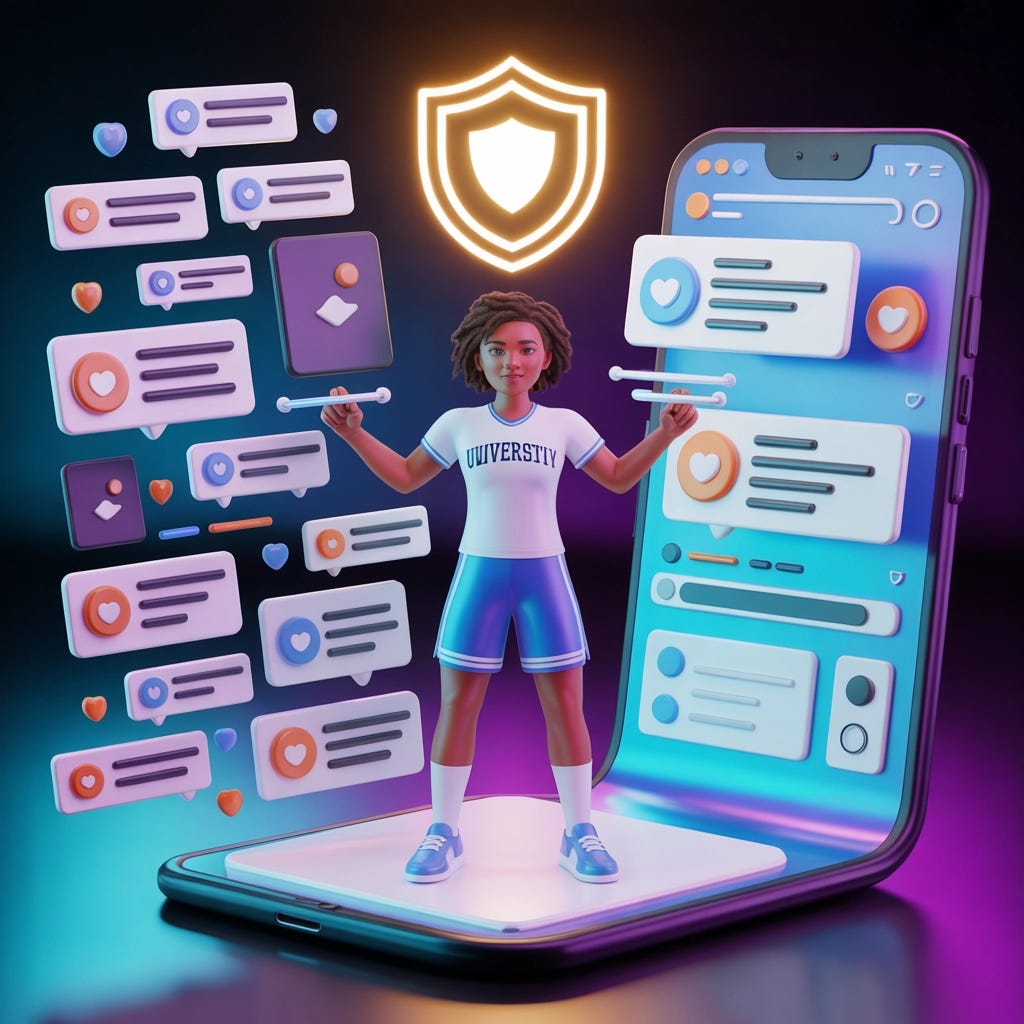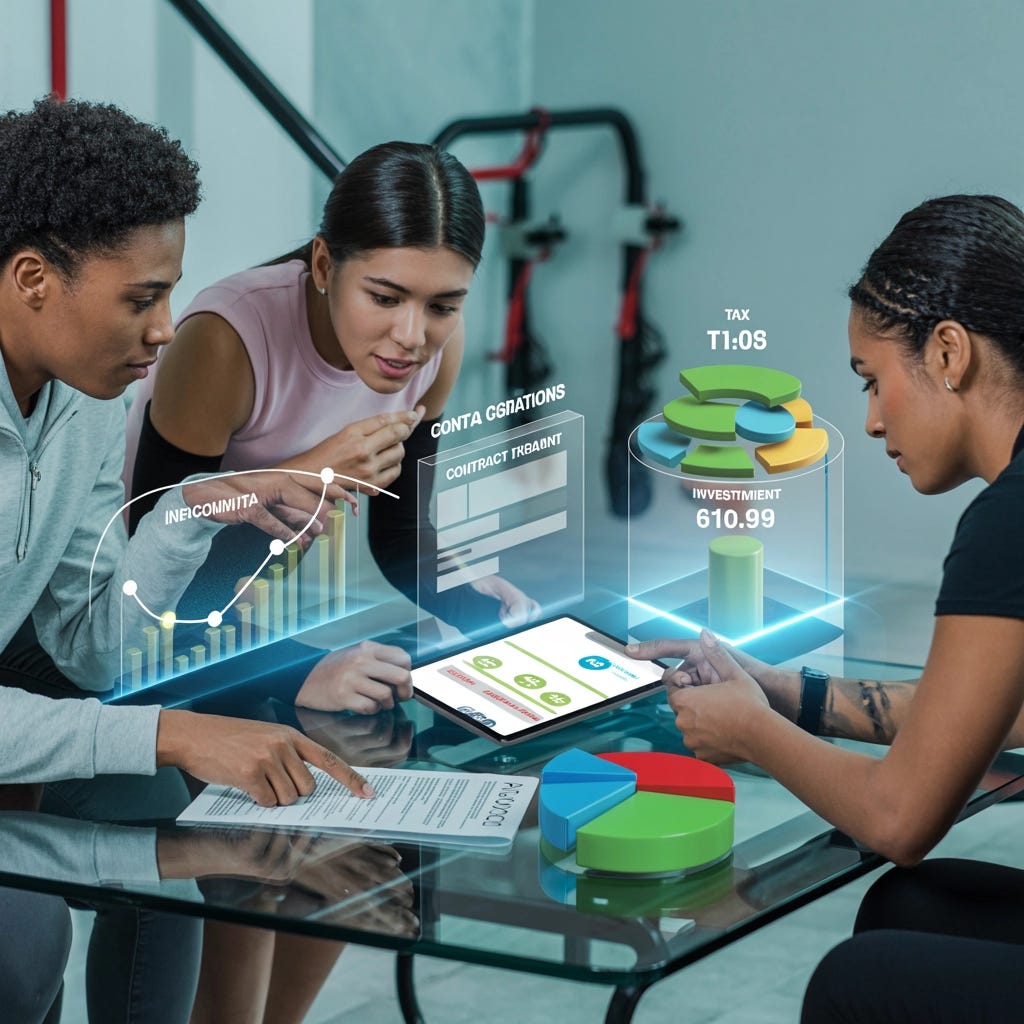The New Reality of Student-Athlete Life
Today's student-athletes face a reality their predecessors never imagined. With the introduction of Name, Image, and Likeness (NIL) opportunities, college athletes have transformed from amateur competitors into potential brand ambassadors, content creators, and entrepreneurs—all while balancing rigorous academic and athletic demands.
This new landscape offers unprecedented opportunities, but it also creates unique pressures. Student-athletes now navigate the complex world of social media scrutiny, where every post, comment, and like can impact their personal brand and future earning potential. The statistics tell a compelling story: according to recent surveys, over 75% of student-athletes report feeling pressure to maintain an active social media presence, and nearly 60% admit to anxiety about how their online personas might affect NIL opportunities.
The Double-Edged Sword of Social Media
Social media platforms have become essential tools for student-athletes looking to build their personal brands and attract NIL deals. These platforms offer direct access to fans, potential sponsors, and broader audiences that were previously unreachable without professional representation.
However, the benefits come with significant challenges:
Constant Scrutiny: Unlike professional athletes with PR teams, many student-athletes manage their social media presence independently, often without formal training or guidance.
Time Demands: Creating quality content, engaging with followers, and managing multiple platforms requires substantial time—a precious commodity for student-athletes.
Cyberbullying and Criticism: Student-athletes face disproportionate levels of online criticism, from game performance critiques to personal attacks.
Comparison Traps: Seeing peers secure lucrative NIL deals can trigger feelings of inadequacy or FOMO (fear of missing out).
The Mental Health Impact
The mental health challenges associated with social media and NIL pressures cannot be overstated. According to sports psychologists, student-athletes today experience unique stressors that can significantly impact their wellbeing:
Identity Confusion: When an athlete's personal brand becomes intertwined with their athletic performance, losses or slumps can trigger identity crises.
Anxiety and Depression: The pressure to perform both on the field and online can exacerbate existing mental health conditions.
Sleep Disruption: The addictive nature of social media, combined with the pressure to remain visible online, often leads to unhealthy sleep patterns.
Perfectionism: The curated nature of social media creates unrealistic standards of perfection in all areas of life.
A recent NCAA study found that student-athletes who spent more than two hours daily on social media reported higher levels of anxiety and lower satisfaction with their athletic performance compared to those who limited their social media use.
Building a Healthy Relationship with Social Media
Despite these challenges, student-athletes can develop strategies to maintain a healthy relationship with social media while maximizing its benefits:
1. Set Clear Boundaries
Establish specific times for social media use, and create "no-phone zones" during critical periods like practice, competition preparation, and study time. Many successful student-athletes designate particular days or hours for content creation, separate from their athletic and academic responsibilities.
2. Quality Over Quantity
Rather than attempting to maintain a presence on every platform, focus on one or two channels that align with your personal brand and target audience. Creating meaningful content on fewer platforms often yields better results than scattered posts across many.
3. Utilize Privacy Settings
Learn to leverage privacy tools on each platform to control who can comment on posts, send messages, or view certain content. This creates a safer digital environment and reduces exposure to negative interactions.
4. Practice Mindful Consumption
Be intentional about who you follow and what content you consume. Curate feeds that inspire and motivate rather than trigger comparison or inadequacy.
Navigating NIL Opportunities Wisely
The NIL era has democratized earning potential for student-athletes across all sports, not just those in high-profile programs. However, navigating these opportunities requires education and strategy:
Understanding Your Value
Many student-athletes underestimate or overestimate their market value. Factors that influence NIL potential include:
Social media following and engagement rates
Sport popularity and program visibility
Personal story and unique attributes
Community connections and local market opportunities
At Gameplan NIL, we've observed that athletes who understand these elements make more informed decisions about which opportunities to pursue and how to price their services.
Diversifying Revenue Streams
The most successful student-athletes in the NIL space don't rely on a single type of deal. Consider various opportunities:
Content creation partnerships: Creating sponsored content for brands on social media
Appearance fees: In-person events, signings, and speaking engagements
Merchandise sales: Personal branded products or collaborations
Endorsements: Traditional product endorsements and advertisements
Coaching and camps: Sharing expertise through instructional opportunities
Protecting Your Reputation
Not all NIL opportunities are created equal. Before entering any agreement, consider:
Does the brand or product align with your personal values?
How might this partnership impact future opportunities?
What are the contractual obligations and time commitments?
Are there potential conflicts with team, conference, or NCAA regulations?
Financial Literacy: The Missing Piece
Perhaps the most overlooked aspect of NIL readiness is financial literacy. Many student-athletes receive significant income for the first time through NIL deals, often without the knowledge to manage it effectively.
Essential financial skills include:
Budgeting fundamentals: Understanding cash flow, saving, and planning
Tax implications: NIL income is taxable and may require quarterly estimated payments
Investment basics: Learning how to grow wealth responsibly
Contract evaluation: Understanding deal terms, payment structures, and obligations
Educational platforms that provide these fundamentals, such as the financial literacy modules offered through Gameplan NIL's comprehensive support system, can make the difference between fleeting NIL success and long-term financial stability.
Building a Support System
No student-athlete should navigate these challenges alone. A robust support system might include:
Mentors: Former athletes who have experience with brand-building and social media
NIL advisors: Professionals who understand the landscape and opportunities
Mental health resources: Counselors familiar with athlete-specific pressures
Academic advisors: To help balance NIL activities with educational priorities
Financial advisors: Professionals who can provide guidance on money management
Practical Tips for Daily Balance
For student-athletes feeling overwhelmed, these practical strategies can help create balance:
Batch content creation: Dedicate specific blocks of time to create multiple posts or content pieces at once.
Use scheduling tools: Platforms like Buffer or Later allow pre-scheduling posts when you're focused on athletics or academics.
Create boundaries with sponsors: Be clear about response times and availability with brand partners.
Prioritize recovery: Mental and physical rest remains essential; don't sacrifice sleep for social media engagement.
Practice digital detox: Implement regular periods completely disconnected from social media.
The Long Game: Beyond College Athletics
The skills developed while managing NIL opportunities and social media presence extend far beyond college athletics. Today's student-athletes are building transferable skills in:
Personal branding
Content creation
Business negotiation
Financial management
Public speaking and communication
Network building
These competencies will serve them well regardless of whether they pursue professional athletics or enter other career paths.
Conclusion: Thriving Holistically
The NIL era presents unprecedented opportunities for student-athletes to benefit from their talents and hard work. However, true success in this space requires more than just accumulating followers or signing deals.
The student-athletes who truly thrive are those who maintain perspective, prioritize wellbeing, and view NIL as one component of a balanced life that includes athletic development, academic growth, meaningful relationships, and personal health.
By approaching social media and NIL opportunities with intention and wisdom, today's student-athletes can leverage these tools to enhance their college experience rather than detract from it—creating foundations for success that will serve them well throughout their lives.
For those looking to navigate this complex landscape with confidence, educational resources and supportive communities like Gameplan NIL provide the guidance needed to transform potential pressures into genuine opportunities for growth.









